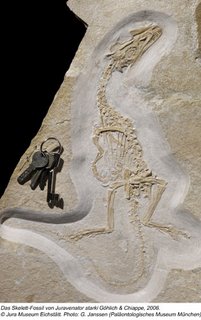INHIGEO - meeting em Eichstatt (Alemanha)

INHIGEO-meeting in Eichstätt, Germany
(July 28th to August 5th, 2007)
first circular (call for papers)
“The historical relationship of geology and religion”
For thousands of years, religious ideas have shaped thoughts and deeds of human beings, and therefore many early geological concepts were initially developed in this context. The meeting will offer a stage to openly discuss from a historical point of view this long-standing relationship, which in the past has been sometimes indifferent, sometimes fruitful, and sometimes full of conflict.
Specific topics, which spring to mind, are, for example:
religious interpretations of the nature of the Earth and its history
the age of the earth in different religions, cultures and times
the (Darwinian) theory of evolution and creation
geological research with religious motivation (such as “natural theology”)
life and work of geological authors with a religious/clerical background
geological institutions (museums, collections) run by religious organisations, etc.
We are sure that you will think of many more aspects of this fascinating topic, and we also hope that you keep in mind that we are talking about Religion in general, not just Christianity.
There are two reasons why we think of Eichstätt as a most appropriate site for such a meeting. As is befitting for INHIGEO, one is geological and one historical.
The region around Eichstätt and Solnhofen is one of the classical geological localities. In the quarries around these two localities the early bird Archaeopteryx was found – one of the key arguments in the debate about biological evolution. And it is here where the most valuable lithographic limestone is quarried. Lithographs have been used, since about 1800, for many geological and palaeontological illustrations.
The small city of Eichstätt presents itself in baroque attire, having suffered badly during the Thirty-Years War. At that time, Eichstätt was capital of a small independent country with the local bishop as head of state. Until today Eichstätt remains a bishop’s town and harbours the main campus of the Catholic University Eichstätt-Ingolstadt. Apart from other collections and responsibilities, the Bishop’s Seminary traditionally houses a natural history collection, which originated in 1844. Throughout the 19th century and up until the 1960s, this collection was used by the church for scientific and educational purposes. Since 1976, part of the collection – with one original Archaeoteryx specimen, among many other stunningly beautiful fossils – is shown in the Jura-Museum Eichstätt. Here, the relationship between religion and geology is practiced daily.
Scientific Sessions (Monday, July 30th, to Friday, August 3rd, 2007)
- Monday, July 30th, 2007; morning: opening reception in the hall of mirrors of the historical palace of Eichstätt; introduction to the fruitful historical relationship between geology and religion in Eichstätt; guided tour through the palace and the city.
Afternoon, July 30th, and second day, July 31st: presentation of scientific papers in the old Jesuits’ refectory of the Bishop’s Seminary in Eichstätt.
Evening of July 30th: visit to and party in the Jura-Museum, which is situated in the castle of Eichstätt. We plan a special exhibition on the natural history collections of the Bishop’s Seminary.
- Wednesday, August 1st, 2007: fieldtrip to see the limestone quarries and a lithographic workshop.
- Thursday and Friday, August 2nd and 3rd, 2007: two more days of scientific papers
Evening of Thursday, August 2nd, 2007: conference dinner
The conference language will be English.
Additional Field-Trips
In addition to the scientific sessions and the one-day field-trip already mentioned, two additional field-trips will be organized:
- pre-conference field-trip (2 days, July 28th and 29th, 2007) featuring the “Swabian Volcano”, karst features on the Swabian Alb, the famous Posidonia Shales of Holzmaden and a most amazing church
- post-conference field-trip (2 days, August 4th and 5th, 2007) featuring the impact craters Steinheim Basin and Ries-Kessel Nördlingen. As you know, until 1960, these structures were commonly regarded as volcanoes. We are going to show you both the volcano and the impact crater in the field.




1 Comments:
best regards, nice info Lucy lawless hockey pictures milf pornstars video breast cancer surgery Refurbished hp plotters ic computers Timeshare for sale in florida Varsity letterman jacket vertical patches
Enviar um comentário
<< Home